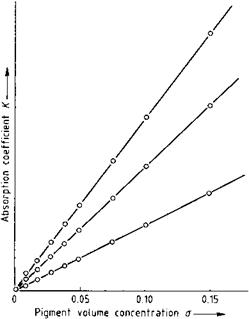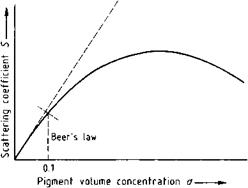The absorption coefficient K obeys Beer’s law, even at high pigment volume concentrations o, and is therefore proportional to a (Figure 1.7). The relationship between the scattering coefficient S and the concentration gives rise to problems, however. The distance between the pigment particles decreases with increasing concentration; consequently there is interaction and hindrance between the light scattered by individual particles, and their scattering power usually falls. The scattering coefficient S is therefore linearly related to concentration only at low concentrations (the Beer’s law region), at higher concentrations it remains below the linear value (Figure 1.8). The concentration dependence of the scattering coefficient can be quantitatively repre-
Fig. 1.7 Absorption coefficient K for diffuse illumination as a function of the pigment volume concentration for three red iron oxide pigments.

 Fig. 1.8 Scattering coefficients as a function of pigment volume concentration.
Fig. 1.8 Scattering coefficients as a function of pigment volume concentration.
sented by using empirical formulae [1.32], e. g., there is a linear relationship between S/a and a[1]/3.
1.3.1.4
 27 августа, 2015
27 августа, 2015  Pokraskin
Pokraskin  Опубликовано в рубрике
Опубликовано в рубрике 